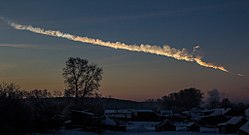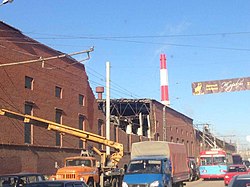Chelyabinsk meteor
The Chelyabinsk meteor (or 2013 Russian meteor event) happened on 15 February 2013 over Chelyabinsk, Russia at about 9:13 a.m.[1] Chelyabinsk is near the Ural Mountains.
The meteor was moving at a speed of about 18 km/s (40,000 mph),[2] it passed over the southern Ural region and exploded in the air over Chelyabinsk Oblast. The air burst occurred at approximately 15 to 25 km (10 to 15 mi) above the ground.[1][3]
The total energy released was equivalent to nearly 500 kilotons of TNT (2.1 PJ),[1][4][5] which would make it 20–30 times more powerful than the atomic bombs detonated at Hiroshima and Nagasaki.[1][4][5][6] The meteor was significantly smaller than objects that are tracked through current efforts by space object scientists, and was not detected before atmospheric entry.[7]
About 1,500 people were injured,[8] mainly by glass from windows shattered by the shock wave; two were reported in serious condition.[4] As many as 3,000 buildings in six cities across the region were damaged as a result of the explosion and impacts.[9][10] The meteor created a dazzling light, bright enough to cast shadows during broad daylight in Chelyabinsk and to be seen as far away as Kazakhstan. Eyewitnesses also felt intense heat from the fireball.[11]
The Chelyabinsk meteor is the largest object known to have entered the Earth's atmosphere since the 1908 Tunguska event, and the only such event known to have resulted in a large number of injuries.[12]
The predicted close approach of the roughly 50 metre asteroid 2012 DA14 occurred about 15 hours later. Sodankylä Geophysical Observatory,[13] NASA,[1] Russian sources,[14] and the European Space Agency,[15] said the two events were not related because they had different trajectories.
No deaths have been reported. It is not related to an asteroid that was also near the Earth on that day.[13][16]
Chelyabinsk Meteor Media
Comparison of possible sizes of the Chelyabinsk (CM mark) and Tunguska meteoroids to the Eiffel Tower and the Empire State Building.
Illustrating all "phases", from atmospheric entry to explosion.
A sample found by Ural Federal University scientists at Lake Chebarkul. The object is part of the Chelyabinsk meteorite.
This visualization shows the aftermath observations by NASA satellites and computer models projections of the plume and meteor debris trajectory around the atmosphere. The plume rose to an altitude of 35 km and once there, it was rapidly blown around the globe by the polar night jet.
A full view of the smoke trail with the bulbous section corresponding to a mushroom cloud's cap.
References
- ↑ 1.0 1.1 1.2 1.3 1.4 "Meteor in central Russia injures at least 500". USA Today. Retrieved 15 February 2013.
- ↑ Major, Jason. "Meteor blast rocks Russia". Universe today. Retrieved 15 February 2013.
- ↑ William Cooke. "Orbit of the Russian meteor". Archived from the original on 7 March 2013. Retrieved 17 February 2013.
- ↑ 4.0 4.1 4.2 Meteorite hits Russian Urals: Fireball explosion wreaks havoc, up to 1,200 injured (PHOTOS, VIDEO). RT. 15 February 2013.
- ↑ 5.0 5.1 Russian meteorite blast explained: Fireball explosion equal to 20 Hiroshimas. RT. 15 February 2013.
- ↑ "Russian meteor hit atmosphere with force of 30 Hiroshima bombs". The Telegraph. 16 February 2013. Archived from the original on 23 April 2013. Retrieved 16 February 2013.
- ↑ "Neil deGrasse Tyson: Radar could not detect meteor". Today. Retrieved 15 February 2013.
- ↑ Число пострадавших при падении метеорита приблизилось к 1500 Archived 2013-05-02 at the Wayback Machine(in Russian)
- ↑ Marson, James; Gautam Naik. "Meteorite hits Russia, causing panic". Wall Street Journal. Retrieved 15 February 2013.
- ↑ Ewait, David. "Exploding meteorite injures a thousand people in Russia". Forbes. Retrieved 15 February 2013.
- ↑ "Eyewitness interview on Youtube". Youtube. Retrieved 15 February 2013.
- ↑ Brumfiel, Geoff Brumfiel. "Russian meteor largest in a century". Nature. Retrieved 15 February 2013.
- ↑ 13.0 13.1 "Are 2012 DA14 and the Chelyabinsk meteor related?". FI: Sodankylä Geophysical Observatory. 15 February 2013. Retrieved 15 February 2013.
- ↑ Leonid Elenin (15 February 2013). "Siberian fireball". Archived from the original on 4 March 2013. Retrieved 15 February 2013.
- ↑ "Russian asteroid strike". ESA.int. Retrieved 16 February 2013.
- ↑ "Russia meteor not linked to asteroid flyby". NASA. 15 February 2013. Archived from the original on 17 February 2013. Retrieved 15 February 2013.
| Wikimedia Commons has media related to Lua error in Module:Commons_link at line 62: attempt to index field 'wikibase' (a nil value).. |








